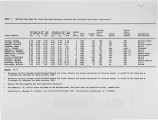| OCR Text |
Show The method used to correct for combustion efficiency is for the program user to input a target carbon conversion percentage. The program then recalculates the ultimate analysis of the fuel as "seen" by the furnace. Further, the program makes a final correction to the apparent equivalence ratio as inputted to the Gordon-McBride code. This equivalence ratio assumes additional oxygen availability due to the lack of complete solid fuel combustion. A typical correction for carbon conversion is shown in Table 2. The third adaptation of the Gordon-McBride code is the construction of a translator to permit inputting variables in conventional engineering terms. This translator pennits inputting ultimate analyses and higher heating values, stoichiometric ratios, oxidant compositions, and reactant temperatures, in English engineering units. Such a translator makes the fmal program more "user friendly" to a broader range of professionals. This translator is the initial program module: PREP. It asks specific questions and requires user inputs. Note that PREP is constructed to handle such specific combustion practices as oxygen enrichment (to minimize stack gas flows an~ in some instances, CO emissions) and extensive combustion air preheating. It can also handle flue gas recirculation, limestone injection into the furnace, and other methods for controlling the formation of airborne emissions. Note, also, that PREP requires inputs describing the underfrre/overfire air ratios. It recognizes the substantial impact of staged combustion on the formation of airborne emissions. Once the questions of PREP have been satisfied, however, the entire system can be operated. Finally, the sensitivity of the G-M model was adjusted such that mole fraction products of combustion are reported down to a level of 1 part per billion (ppb). Construction of Additional Modules. The flame temperature and basic products of combustion yielded as outputs of .the G-M model, as modified, are utilized in the SFCOMB system. Particular products of combustion which are employed include the bulk products: COl' H10, Nl, and 0 1. Further, the acid gases (SOl' HCl, HF) are estimated based upon the adapted G-M program output. This panicular program does not address system efficiency, however. Further, it does not adequately address formation of such emissions as particulates, oxides of nitrogen, and PAH's. It is cumbersome as an analytical tool for estimating the fate of trace metals. Consequently two modules, EFFICIENCY and TRACE were constructed. EFFICIENCY addresses the thermal output of the combustor in question. It is constructed around the conventional heat loss approach to efficiency, depicted by the following equation: Heat available = heat inputs - heat losses (5) Where the sum of the heat inputs include the chemical and sensible heat in the fuel and the sensible heat in the oxidant; and where the sum of the heat losses includes unburned carbon, sensible energy in the bottom ash and flyash, sensible energy in the dry stack gas, sensible heat and latent heat of vaporization in the moisture contained in the stack gas, and radiation and manufacturers margin. Efficiency also calculates the exergy term as defined 7 |








































